-
 The earliest known formal writing system is considered to be cuneiform, developed in ancient Mesopotamia around 3300 BCE, which involved pressing wedge-shaped marks into clay tablets to represent words sounds; it is generally accepted as the first true writing system, with Egyptian hieroglyphs emerging shortly after as another early form of writing.
The earliest known formal writing system is considered to be cuneiform, developed in ancient Mesopotamia around 3300 BCE, which involved pressing wedge-shaped marks into clay tablets to represent words sounds; it is generally accepted as the first true writing system, with Egyptian hieroglyphs emerging shortly after as another early form of writing.
Cuneiform -
-
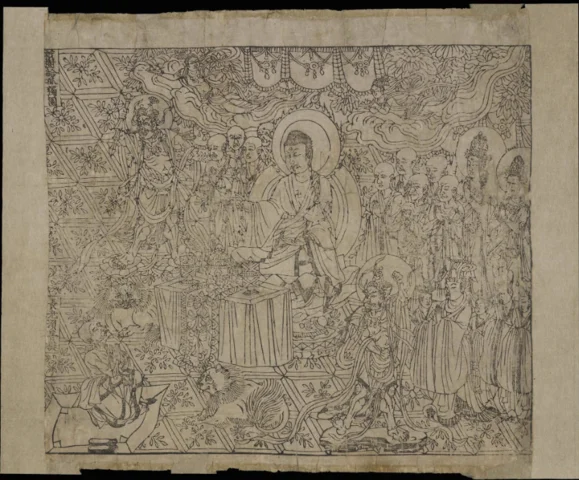 The oldest known printed text is The Diamond Sutra, a Buddhist book from China that dates back to 868 AD. It was printed using woodblocks.
The oldest known printed text is The Diamond Sutra, a Buddhist book from China that dates back to 868 AD. It was printed using woodblocks.
Diamond Sutra -
 Gutenberg began designing the printing press in 1436. He was inspired to create a machine that could produce pages of text quickly to make up for losses from a failed metal mirror business.
Gutenberg began designing the printing press in 1436. He was inspired to create a machine that could produce pages of text quickly to make up for losses from a failed metal mirror business.
Printing Press -
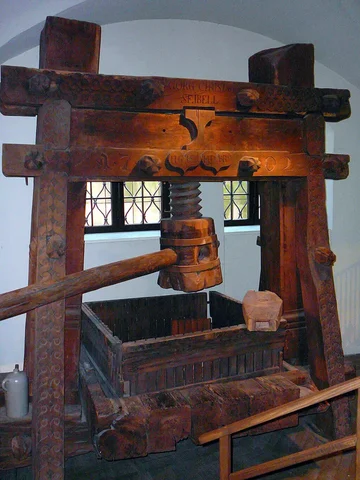 The printing press allowed for the mass production of books. It made books more affordable and accessible to the general public. It contributed to the modernity of Europe during the Renaissance.
The printing press allowed for the mass production of books. It made books more affordable and accessible to the general public. It contributed to the modernity of Europe during the Renaissance.
Printing Press in use -
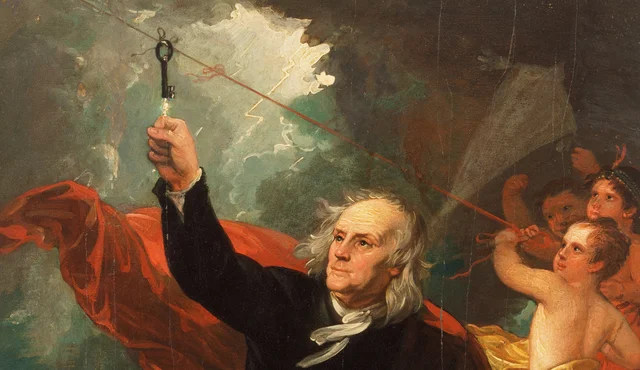 Benjamin Franklin took a kite out during a storm to see if a key attached to the string would draw an electrical charge.
Benjamin Franklin took a kite out during a storm to see if a key attached to the string would draw an electrical charge.
Ben Franklin Experiment -
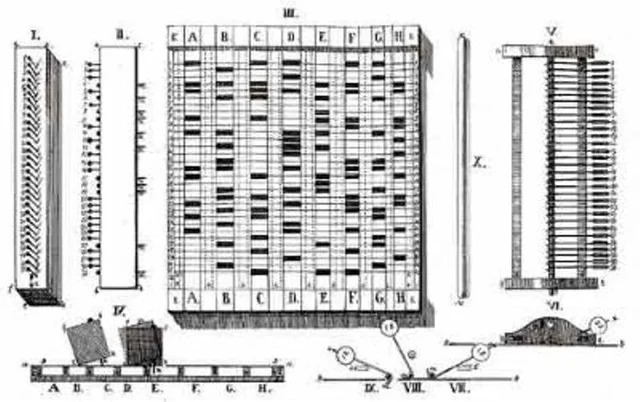 Joseph Marie Jacquard demonstrated in 1801 a loom that enabled unskilled workers to weave complex patterns in silk. The Jacquard Loom is controlled by a chain of multiple cards punched with holes that determine which cords of the fabric warp should be raised for each pass of the shuttle. The ability to store and automatically reproduce complex operations found wide application in textile manufacturing.
Joseph Marie Jacquard demonstrated in 1801 a loom that enabled unskilled workers to weave complex patterns in silk. The Jacquard Loom is controlled by a chain of multiple cards punched with holes that determine which cords of the fabric warp should be raised for each pass of the shuttle. The ability to store and automatically reproduce complex operations found wide application in textile manufacturing.
Loom -
 A difference engine is a mechanical calculator that uses the method of finite differences to calculate and print numerical tables. Created by Charles Babbage.
A difference engine is a mechanical calculator that uses the method of finite differences to calculate and print numerical tables. Created by Charles Babbage.
Difference Engine Blog -
 In 1826, Nicéphore Niépce first managed to fix an image that was captured with a camera, but at least 8 hours or even several days of exposure in the camera were required the earliest results were very crude. Photograph
In 1826, Nicéphore Niépce first managed to fix an image that was captured with a camera, but at least 8 hours or even several days of exposure in the camera were required the earliest results were very crude. Photograph -
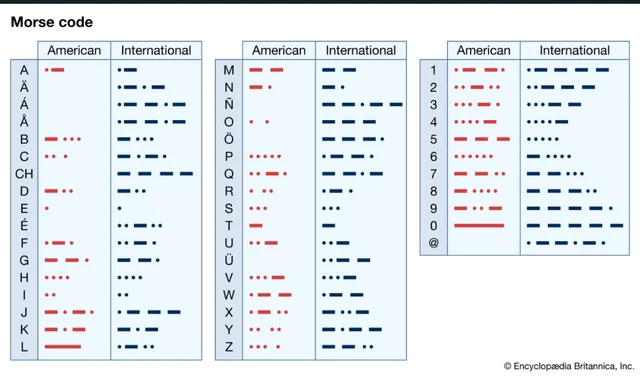 Samuel Morse and Alfred Vail developed Morse code.Morse code is a set of sounds that represent letters of the alphabet. In 1844, Morse sent the first inter-city message using Morse code, "What hath God wrought!". Morse code was later adapted for wireless radio and was used extensively in early radio communication. Morse code was also a vital form of communication during World War II.
Samuel Morse and Alfred Vail developed Morse code.Morse code is a set of sounds that represent letters of the alphabet. In 1844, Morse sent the first inter-city message using Morse code, "What hath God wrought!". Morse code was later adapted for wireless radio and was used extensively in early radio communication. Morse code was also a vital form of communication during World War II.
Morse Code -
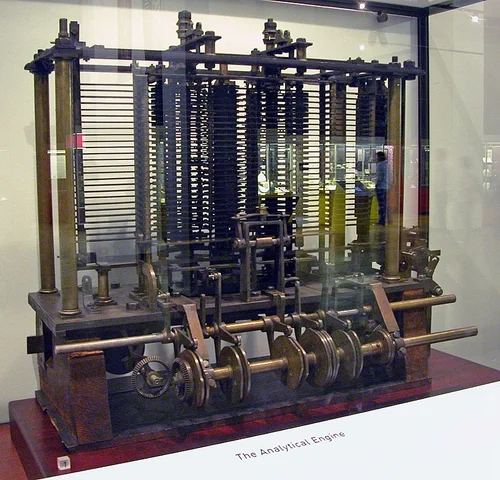 The Analytical Engine was never built, but its design was recorded. Ada Lovelace created “the first computer program” that presents a complete simultaneous view of all the successive changes in the components of the machine as the calculation progresses. The table is what computer scientists would now call an “execution trace”.
The Analytical Engine was never built, but its design was recorded. Ada Lovelace created “the first computer program” that presents a complete simultaneous view of all the successive changes in the components of the machine as the calculation progresses. The table is what computer scientists would now call an “execution trace”.
Analytical Enging photo -
 Alexander Graham Bell invented the telephone, which allowed people to transmit sounds over a distance. Bell's telephone was the first to be patented and is considered the beginning of the modern telephone. The first call Bell made famously said "Mr. Watson, come here, I want to see you" into the telephone to his assistant, Thomas Watson, who was listening in another room.
Alexander Graham Bell invented the telephone, which allowed people to transmit sounds over a distance. Bell's telephone was the first to be patented and is considered the beginning of the modern telephone. The first call Bell made famously said "Mr. Watson, come here, I want to see you" into the telephone to his assistant, Thomas Watson, who was listening in another room.
Telephone -
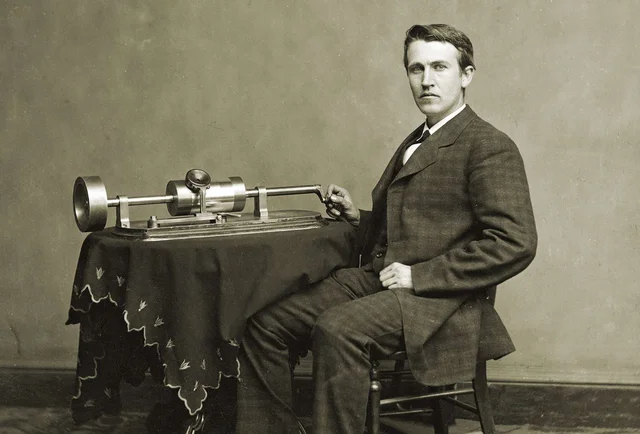 A phonograph is a device that records and plays back sounds. It was invented by Thomas Edison in 1877. The phonograph was the first machine to do both. A phonograph uses a stylus or needle to follow a groove on a rotating disc or cylinder.
A phonograph is a device that records and plays back sounds. It was invented by Thomas Edison in 1877. The phonograph was the first machine to do both. A phonograph uses a stylus or needle to follow a groove on a rotating disc or cylinder.
The stylus vibrates as it follows the groove, reproducing the sound waves stored in the groove.
The phonograph's large horn amplifies the sound.
Phonograph -
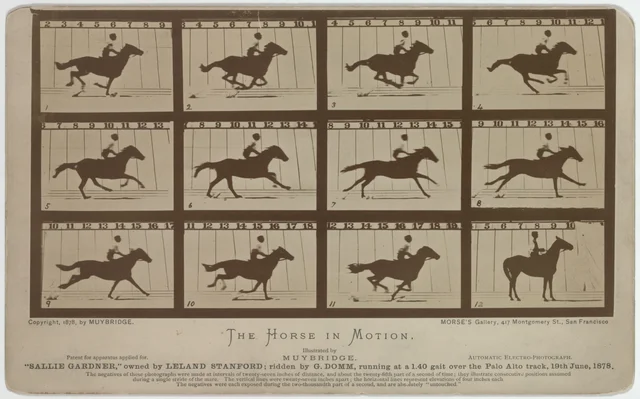 Eadweard Muybridge is credited with inventing sequential photography. The Horse in Motion photos were the first known sequential photographs. His work was a foundation for motion picture cameras and projectors because he developed the process for making rapid sequences of photographs of motion. Sequential Photography
Eadweard Muybridge is credited with inventing sequential photography. The Horse in Motion photos were the first known sequential photographs. His work was a foundation for motion picture cameras and projectors because he developed the process for making rapid sequences of photographs of motion. Sequential Photography -
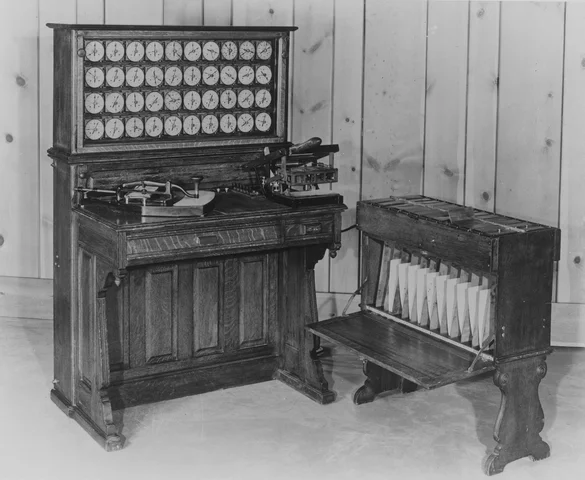 Invented by Herman Hollerith, the machine was developed to help process data for the 1890 U.S. Census. Later models were used for business applications such as accounting inventory control. It became used for the data processing industry.Tabulating Machine
Invented by Herman Hollerith, the machine was developed to help process data for the 1890 U.S. Census. Later models were used for business applications such as accounting inventory control. It became used for the data processing industry.Tabulating Machine -
 The first recording, workable adding and listing machine is built patented in St. Lewis, Missouri, by William Seward Burroughs. It's a type of calculator used for performing simple arithmetical operations.
The first recording, workable adding and listing machine is built patented in St. Lewis, Missouri, by William Seward Burroughs. It's a type of calculator used for performing simple arithmetical operations.
Adding Machine -
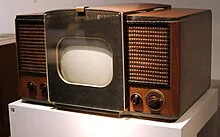 Philo Taylor Farnsworth invented the first working electronic television in 1927. Farnsworth's invention of the image dissector, the first fully functional electronic camera tube, made possible all modern video. Television
Philo Taylor Farnsworth invented the first working electronic television in 1927. Farnsworth's invention of the image dissector, the first fully functional electronic camera tube, made possible all modern video. Television -
 The first TV show was The Queen's Messenger, a one-act drama broadcast on September 11, 1928 from WGY radio station in Schenectady, New York. The show was filmed and broadcast live. First TV Show
The first TV show was The Queen's Messenger, a one-act drama broadcast on September 11, 1928 from WGY radio station in Schenectady, New York. The show was filmed and broadcast live. First TV Show -
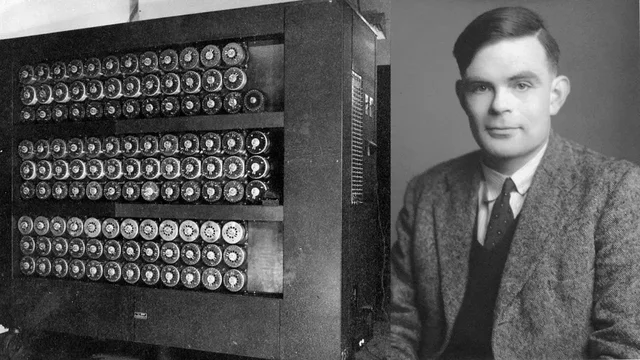 Turing machine, hypothetical computing device introduced in 1936 by the English mathematician and logician Alan M. Turing. Turing originally conceived the machine as a mathematical tool that could infallibly recognize undecidable propositions.Turing Machine
Turing machine, hypothetical computing device introduced in 1936 by the English mathematician and logician Alan M. Turing. Turing originally conceived the machine as a mathematical tool that could infallibly recognize undecidable propositions.Turing Machine -
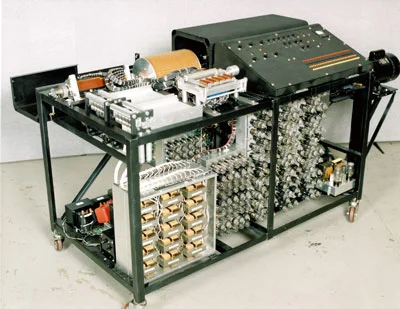 John Vincent Atanasoff's first computer was the Atanasoff-Berry Computer (ABC), which he built with his graduate student Clifford Berry at Iowa State University. The ABC was the first electronic digital computer. ABC
John Vincent Atanasoff's first computer was the Atanasoff-Berry Computer (ABC), which he built with his graduate student Clifford Berry at Iowa State University. The ABC was the first electronic digital computer. ABC -
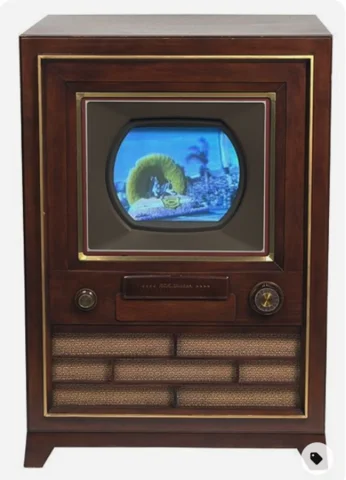 The first practical example of this sort of system was again pioneered by John Logie Baird. In 1940 he publicly demonstrated a color television combining a traditional black-and-white display with a rotating colored disk. RCA Laboratories demonstrated their system at the Franklin Institute in Philadelphia in 1947. First Color TV
The first practical example of this sort of system was again pioneered by John Logie Baird. In 1940 he publicly demonstrated a color television combining a traditional black-and-white display with a rotating colored disk. RCA Laboratories demonstrated their system at the Franklin Institute in Philadelphia in 1947. First Color TV -
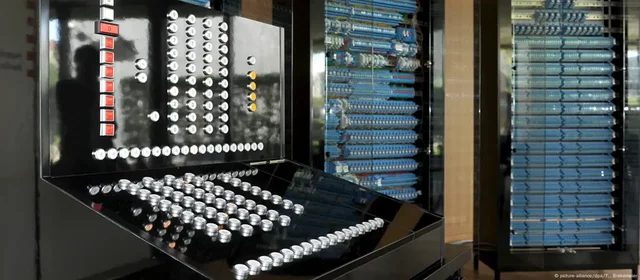 The Z3 was a German electromechanical computer designed by Konrad Zuse in 1938, and completed in 1941. It was the world's first working programmable, fully automatic digital computer. The Z3 was built with 2,600 relays, implementing a 22-bit word length that operated at a clock frequency of about 5–10 Hz.First Computer
The Z3 was a German electromechanical computer designed by Konrad Zuse in 1938, and completed in 1941. It was the world's first working programmable, fully automatic digital computer. The Z3 was built with 2,600 relays, implementing a 22-bit word length that operated at a clock frequency of about 5–10 Hz.First Computer -
 John Mauchly co-invented the Electronic Numerical Integrator and Computer (ENIAC), the world's first general-purpose electronic computer. ENIAC could add 5,000 numbers in one second. ENIAC had no internal storage, so it had to be rewired manually for each new set of calculations. ENIAC was originally built to calculate World War II ballistic firing tables. ENIAC
John Mauchly co-invented the Electronic Numerical Integrator and Computer (ENIAC), the world's first general-purpose electronic computer. ENIAC could add 5,000 numbers in one second. ENIAC had no internal storage, so it had to be rewired manually for each new set of calculations. ENIAC was originally built to calculate World War II ballistic firing tables. ENIAC -
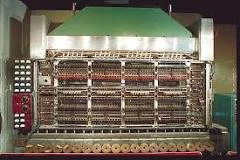 The IAS (Institute for Advanced Study) machine was invented at Princeton University in New Jersey by mathematician John von Neumann. The IAS machine was the first electronic computer. The IAS machine was a binary computer with a 40-bit word, storing two 20-bit instructions in each word. The memory was 1,024 words. Negative numbers were represented in two's complement format. IAS Machine
The IAS (Institute for Advanced Study) machine was invented at Princeton University in New Jersey by mathematician John von Neumann. The IAS machine was the first electronic computer. The IAS machine was a binary computer with a 40-bit word, storing two 20-bit instructions in each word. The memory was 1,024 words. Negative numbers were represented in two's complement format. IAS Machine -
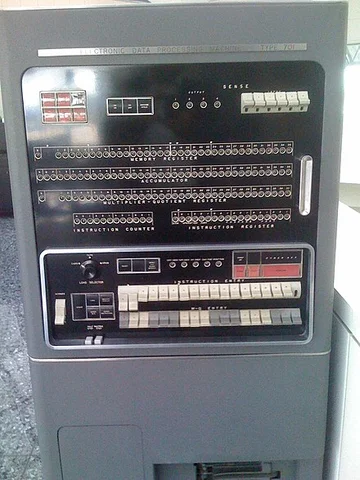 The IBM 701 Electronic Data Processing Machine, known as the Defense Calculator while in development, was IBM’s first commercial scientific computer and its first series production mainframe computer. It was designed and developed by Jerrier Haddad and Nathaniel Rochester and was based on the IAS machine at Princeton. IBM 701
The IBM 701 Electronic Data Processing Machine, known as the Defense Calculator while in development, was IBM’s first commercial scientific computer and its first series production mainframe computer. It was designed and developed by Jerrier Haddad and Nathaniel Rochester and was based on the IAS machine at Princeton. IBM 701 -
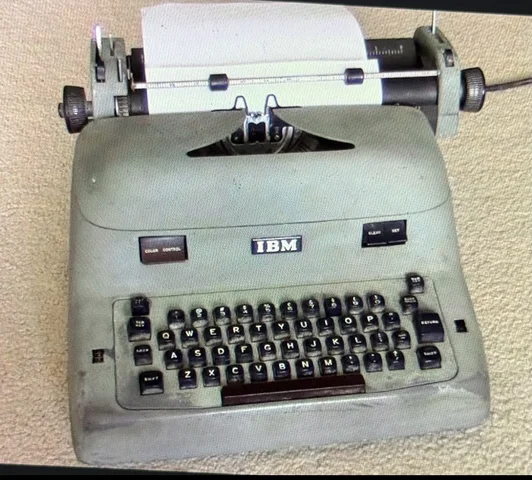 The first electrically operated typewriter, consisting of a printing wheel, was invented by Thomas Edison in 1872 later developed into the ticker-tape printer. The electric typewriter as an office writing machine was pioneered by James Smathers in 1920. In 1961 the 1st commercially successful typewriter based on a spherical type-carrier design was introduced by the International Business Machines Corporation. Electric Typewriter
The first electrically operated typewriter, consisting of a printing wheel, was invented by Thomas Edison in 1872 later developed into the ticker-tape printer. The electric typewriter as an office writing machine was pioneered by James Smathers in 1920. In 1961 the 1st commercially successful typewriter based on a spherical type-carrier design was introduced by the International Business Machines Corporation. Electric Typewriter -
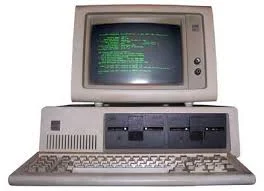 This generation is upgraded compared to the other two previous generations. Third-generation computers used integrated circuits in place of transistors. With the use of integrated circuits, these computers became reliable, generated less heat, were small in size, fast, very less maintenance, and were inexpensive.
This generation is upgraded compared to the other two previous generations. Third-generation computers used integrated circuits in place of transistors. With the use of integrated circuits, these computers became reliable, generated less heat, were small in size, fast, very less maintenance, and were inexpensive.
Third Generation Computers -
 Intel's 4004 microprocessor was the first commercial microprocessor, and it was made up of 2,300 transistors. 1971: Intel releases the 4004 microprocessor 1981: IBM releases the first personal computer (PC) 1984: Apple introduces the Macintosh line. 4th Generation Computers
Intel's 4004 microprocessor was the first commercial microprocessor, and it was made up of 2,300 transistors. 1971: Intel releases the 4004 microprocessor 1981: IBM releases the first personal computer (PC) 1984: Apple introduces the Macintosh line. 4th Generation Computers -
 Martin Cooper, an engineer at Motorola, invented the first cell phone in 1973. Cooper's prototype, the DynaTAC, was a brick-like device that weighed over 2 pounds and took 10 hours to charge. First Cell Phone
Martin Cooper, an engineer at Motorola, invented the first cell phone in 1973. Cooper's prototype, the DynaTAC, was a brick-like device that weighed over 2 pounds and took 10 hours to charge. First Cell Phone -
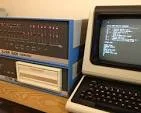 A personal computer is intended for interactive individual use, as opposed to a mainframe computer where the end user's requests are filtered through operating staff, or a time-sharing system in which one large processor is shared by many individuals. The Altair 8800 is the 1st commercially successful personal computer. It was sold as a kit for $439 unassembled helped kickstart the PC revolution. Personal Computers
A personal computer is intended for interactive individual use, as opposed to a mainframe computer where the end user's requests are filtered through operating staff, or a time-sharing system in which one large processor is shared by many individuals. The Altair 8800 is the 1st commercially successful personal computer. It was sold as a kit for $439 unassembled helped kickstart the PC revolution. Personal Computers -
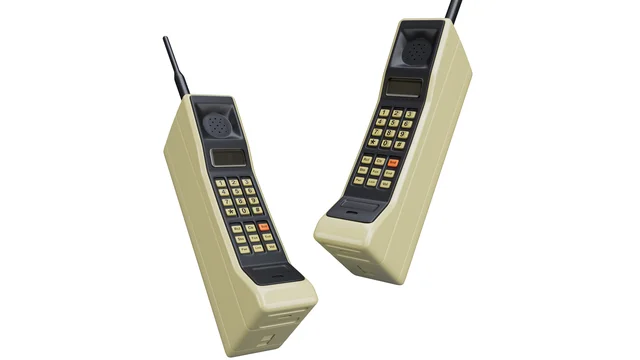 he first commercially available cell phone was the Motorola DynaTAC 8000x, which was approved by the FCC on September 21, 1983. It was 9 inches tall, 2.5 pounds, 30 minutes of battery life, Took about 10 hours to charge, and sold for $4,000. Cell Phone
he first commercially available cell phone was the Motorola DynaTAC 8000x, which was approved by the FCC on September 21, 1983. It was 9 inches tall, 2.5 pounds, 30 minutes of battery life, Took about 10 hours to charge, and sold for $4,000. Cell Phone -
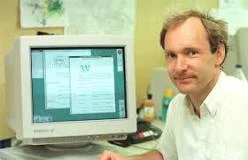 Tim Berners-Lee, a British scientist, invented the World Wide Web (WWW) in 1989 while working at CERN. The WWW was created to allow scientists to share information automatically across universities and institutes around the world. World Wide Web
Tim Berners-Lee, a British scientist, invented the World Wide Web (WWW) in 1989 while working at CERN. The WWW was created to allow scientists to share information automatically across universities and institutes around the world. World Wide Web -
 In 1989 the University of Phoenix became the first institution to launch a fully online collegiate institution that offered both bachelors and masters degrees. Since the creation of these fully online programs and schools, distance learning has continued to grow in many different directions. Online Education
In 1989 the University of Phoenix became the first institution to launch a fully online collegiate institution that offered both bachelors and masters degrees. Since the creation of these fully online programs and schools, distance learning has continued to grow in many different directions. Online Education -
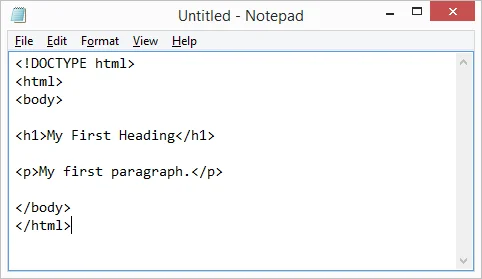 Tim Berners-Lee, a physicist at CERN, invented HyperText Markup Language (HTML) in 1991. HTML is a markup language used to create web pages. It consists of a series of commands, known as tags, that instruct a browser on how to interpret content. HTML
Tim Berners-Lee, a physicist at CERN, invented HyperText Markup Language (HTML) in 1991. HTML is a markup language used to create web pages. It consists of a series of commands, known as tags, that instruct a browser on how to interpret content. HTML -
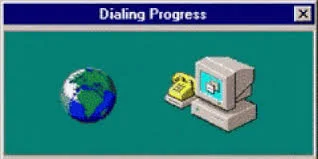 In the 1990s connecting to the Internet from home generally meant using a dial-up modem connected to your telephone line. Early dial-up modems typically offered speeds of 14,400 bits per second, increasing to 56,000 by the end of the decade. Dial-Up Internet
In the 1990s connecting to the Internet from home generally meant using a dial-up modem connected to your telephone line. Early dial-up modems typically offered speeds of 14,400 bits per second, increasing to 56,000 by the end of the decade. Dial-Up Internet -
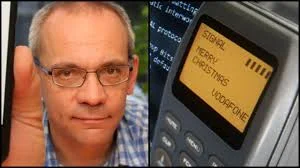 Neil Papworth sent the first text message on December 3, 1992. The message was "Merry Christmas" and was sent from a computer to Richard Jarvis's phone. He was working on a Short Message Service (SMS) for Vodafone. Papworth typed the message on a computer because mobile phones didn't have keyboards at the time. Texting
Neil Papworth sent the first text message on December 3, 1992. The message was "Merry Christmas" and was sent from a computer to Richard Jarvis's phone. He was working on a Short Message Service (SMS) for Vodafone. Papworth typed the message on a computer because mobile phones didn't have keyboards at the time. Texting -
 America Online (AOL) was one of the first companies to provide internet access to the public. AOL offered dial-up internet access and other online services. Connect to the internet using your phone line. You need an AOL Advantage Plan membership to use AOL Dialer. A browser that works with dial-up internet connections and older operating systems. AOL
America Online (AOL) was one of the first companies to provide internet access to the public. AOL offered dial-up internet access and other online services. Connect to the internet using your phone line. You need an AOL Advantage Plan membership to use AOL Dialer. A browser that works with dial-up internet connections and older operating systems. AOL -
 Tim Berners-Lee essentially opened up access to the web to anyone in the world, making it free easy to explore the nascent internet. Web browsers like Mosaic appeared a short time later, before long the Web had become by far the most popular system of its kind. Within a matter of years, the web had revolutionized information-sharing and had dramatically altered the way that humans communicated. Public Web
Tim Berners-Lee essentially opened up access to the web to anyone in the world, making it free easy to explore the nascent internet. Web browsers like Mosaic appeared a short time later, before long the Web had become by far the most popular system of its kind. Within a matter of years, the web had revolutionized information-sharing and had dramatically altered the way that humans communicated. Public Web -
 The first smartphone prototype, Simon Personal Communicator, was available for purchase in 1994. The SPC was the 1st touchscreen phone could send receive emails faxes. It had a calendar, address book, appointment scheduler. The SPC had a small monochrome LCD screen a 1 hour battery life.
The first smartphone prototype, Simon Personal Communicator, was available for purchase in 1994. The SPC was the 1st touchscreen phone could send receive emails faxes. It had a calendar, address book, appointment scheduler. The SPC had a small monochrome LCD screen a 1 hour battery life.
First Smartphone -
 The Global Positioning System (GPS) was launched for public use on July 17, 1995. Prior to that, GPS was primarily used by the United States military and was not available for civilian use. The decision to make GPS available for civilian use was made by President Bill Clinton in 1996, and since then, GPS has become an essential technology for navigation, mapping, and other applications around the world. GPS
The Global Positioning System (GPS) was launched for public use on July 17, 1995. Prior to that, GPS was primarily used by the United States military and was not available for civilian use. The decision to make GPS available for civilian use was made by President Bill Clinton in 1996, and since then, GPS has become an essential technology for navigation, mapping, and other applications around the world. GPS -
 Andrew Weinreich is credited with inventing social media with the launch of SixDegrees in 1997. SixDegrees was the first social media site to allow users to create profiles and connect with others using their real names. Early social media websites include:
Andrew Weinreich is credited with inventing social media with the launch of SixDegrees in 1997. SixDegrees was the first social media site to allow users to create profiles and connect with others using their real names. Early social media websites include:
SixDegrees, Classmates.com, GeoCities, AIM, BBS, IRC. Social Media's rise to popularity include:
MySpace, Friendster, Facebook, YouTube, Twitter, Reddit. Social Media -
 The first true texting phone came out in 1997 when Nokia released the 90001 Communicator with a full QWERTY keyboard. In 1999, users start exchanging text messages between different networks. Cross-network text messaging makes it possible for businesses to start texting with their customers. Texting
The first true texting phone came out in 1997 when Nokia released the 90001 Communicator with a full QWERTY keyboard. In 1999, users start exchanging text messages between different networks. Cross-network text messaging makes it possible for businesses to start texting with their customers. Texting -
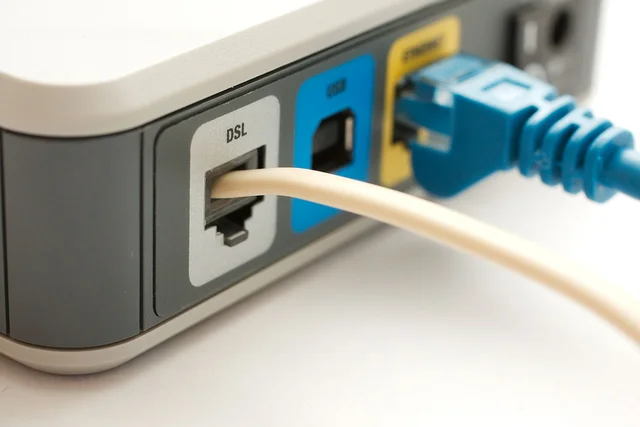 John Cioffi developed the technology that would ultimately make possible video calls and much more including high-speed Internet. In 1991 he built the first asymmetric digital subscriber line (DSL) modem, which quickly replaced most dial-up connections. It did not become widely available to the public until the mid-to-late 1990s. DSL
John Cioffi developed the technology that would ultimately make possible video calls and much more including high-speed Internet. In 1991 he built the first asymmetric digital subscriber line (DSL) modem, which quickly replaced most dial-up connections. It did not become widely available to the public until the mid-to-late 1990s. DSL -
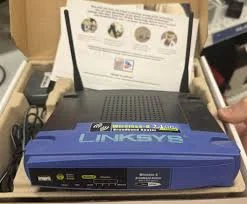 In 1999, the WECA (later WiFi) Alliance Interbrand coin the term “WiFi”. However, it wasn't until 2004 that WiFi started gaining popularity. In 2004, WiFi 4 became the first standard to use both 2.4 GHz and 5 GHz frequency bands. By 2012, almost 25% of global households had WiFi. [WiFi](https://fon.com/fon-wifi-infographic/#:~:text=1999%20The%20WECA%20(later%20WiFi,and%20TVs%2C%20hit%20the%20market.)
In 1999, the WECA (later WiFi) Alliance Interbrand coin the term “WiFi”. However, it wasn't until 2004 that WiFi started gaining popularity. In 2004, WiFi 4 became the first standard to use both 2.4 GHz and 5 GHz frequency bands. By 2012, almost 25% of global households had WiFi. [WiFi](https://fon.com/fon-wifi-infographic/#:~:text=1999%20The%20WECA%20(later%20WiFi,and%20TVs%2C%20hit%20the%20market.) -
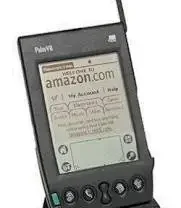 The first tablet to use cellular data was the Palm VII, released in 1999 by Palm Inc. Used the Mobitex wireless data network. Allowed users to send and receive emails, access news, weather, and stock updates. It wasn’t a full-fledged internet browser, though. Later, more advanced tablets like the Apple iPad (2010) introduced 3G connectivity, making true mobile internet more mainstream. Tablets
The first tablet to use cellular data was the Palm VII, released in 1999 by Palm Inc. Used the Mobitex wireless data network. Allowed users to send and receive emails, access news, weather, and stock updates. It wasn’t a full-fledged internet browser, though. Later, more advanced tablets like the Apple iPad (2010) introduced 3G connectivity, making true mobile internet more mainstream. Tablets -
 The first laptop with integrated wireless networking was the Apple iBook, which was released in 1999. The iBook was also the first Wi-Fi-enabled laptop. iBook
The first laptop with integrated wireless networking was the Apple iBook, which was released in 1999. The iBook was also the first Wi-Fi-enabled laptop. iBook -
 According to available information, the first widely recognized tablet to utilize Wi-Fi was the Nokia 770 Internet Tablet, which was released in 2005 and primarily designed for wireless internet browsing and email functions; it ran on a Linux-based operating system called Maemo. The tablet computer market was reinvigorated by Apple through the introduction of the iPad device in 2010. WiFi Tablets
According to available information, the first widely recognized tablet to utilize Wi-Fi was the Nokia 770 Internet Tablet, which was released in 2005 and primarily designed for wireless internet browsing and email functions; it ran on a Linux-based operating system called Maemo. The tablet computer market was reinvigorated by Apple through the introduction of the iPad device in 2010. WiFi Tablets -
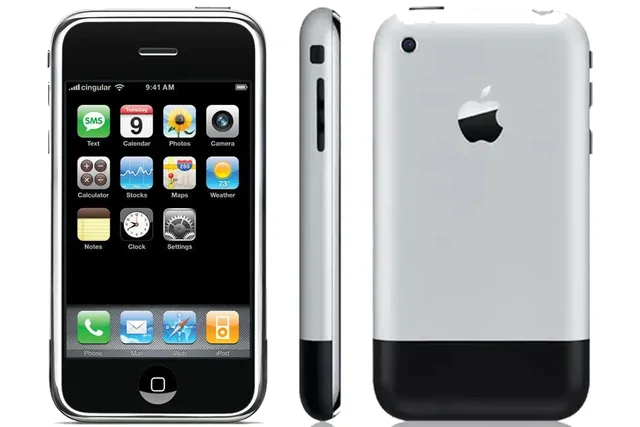 The iPhone, released in 2007, was the first smartphone to offer a user-friendly way to browse the internet with wireless internet access. It also included a touch screen, GPS, camera, and iPod.The iPhone's software capabilities were a turning point for the smartphone industry. Smartphones
The iPhone, released in 2007, was the first smartphone to offer a user-friendly way to browse the internet with wireless internet access. It also included a touch screen, GPS, camera, and iPod.The iPhone's software capabilities were a turning point for the smartphone industry. Smartphones